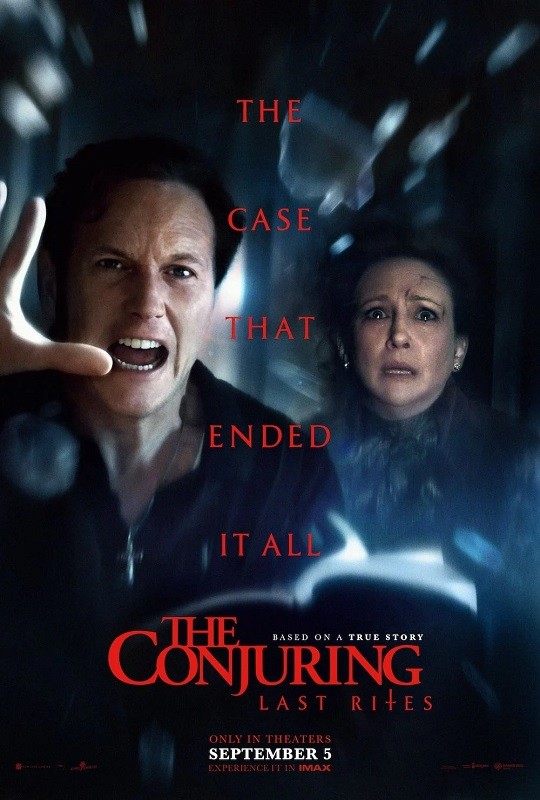The Conjuring: Last Rites
Introduction
It is interesting in the game of cricket wherein a player is told to retire when he is at the top of his game – even as the question asked would be ‘Why’ more than ‘When’. Most players who have been iconic in many ways, have had the most tame endings to their career, given their refusal to acknowledge the slide – thereby putting their reputations in jeopardy. The Conjuring franchise suffers a similar fate here – something that began with chills and frights, is slowly only a shadow of itself. It is interesting how the studio culture wishes to squeeze out the last drop out, before retiring the franchise – a trait that you consistently see as a trend here.
The peak of The Conjuring franchise was in its first outing in 2013, wherein the shivers were felt in the claps that doubled up as nightmares for most Gen Ys back in time. The same folks almost touted the franchise as a welcome followup to yesteryear horror films like The Omen or The Amityville Horror, something that would take the franchise forward. But interestingly, the same tropes that once were perceived to be frightening, has had the audience immune to its screams – a consistent trait that you would notice in the next two Conjuring films or their spin-offs in the form of The Nun or Annabelle. In that regard, the final chapter of the first Conjuring universe in the form of The Conjuring Last Rites, comes at a time fittingly when horror has evolved and at its peak with films like Sinners, Weapons and even Together being a long lists of successes in 2025. And yet, Last Rites feels like a pale shadow of its predecessor, low of chills and high on drama. Either the writing hasn’t evolved, or the viewers have evolved, or both.
Story & Screenplay
It is interesting how there is a considerable effort made to connect the past to the present in The Conjuring: Final Rites. And so, a little homage back in 1964 tells us on how an evil demonic spirit makes its presence felt in the life of Lorraine (Vera Farmiga) who is heavily pregnant with her first child. And the presence of this spirit is linked to Judy (Mia Tomilinson), Lorraine’s daughter who she almost loses during childbirth. With years, Lorraine and Ed (Patrick Wilson) bring up Judy who is consistently marred by haunting visions, a trait that would connect the past to the present. Back in the present with the year being 1986, you witness strange occurences in the Smurl household featuring an intimidating mirror that is anything but a vanity, and an evil looking doll somewhere in the mix. The basic beats of the story includes the Warrens coming out of semi-retirement and taking up their case in what would turn out to be their last.
One of the fundamental mistakes that the drama makes is with respect to the structure – it chooses to focus on the personal lives of Ed and Lorraine, along with Judy who has being dating her boyfriend Tony (Ben Hardy) for over six months. This, even as the events in the Smurl household only threaten to take off without providing the adequate zing to the drama. This template was slightly skewed because the family drama overhauled the horror in a horror film – a trait that will divide the viewers. While there is consistent buildup with respect to the now-retired lives of Ed and Lorraine, the sliver of threat is elsewhere that keeps the duo away from action for a long time. At a point, it even feels that both these incidents are unfolding in isolation – with a little more emphasis given on Judy and Tony, with the former continuing to be marred by visions, and the latter living under a (partial) guilt of leaving his job as a cop. The question it poses is – can love find a voice amidst a family that isn’t normal, and further dealing with paranormal stuff? The legacy of the Warrens is showcased alright but the issue lies elsewhere – this wasn’t the grain of the drama or the franchise in the first place.
Some of the jump-scares along the way didn’t feel like jump-scares simply because the immediate drama leading up to that event, wasn’t emotionally driven. If anything, the emotional connect existing between the Smurls is missing, something that was so evident in the first Conjuring film featuring a character that was ‘possessed’. Yes, these remain true-investigative events alright, but there is a drastic different in presentation, wherein the focus deviates here, leaving with only a couple of horror sequences that are decent – like a character vomitting a pool of blood only to stick out a piece of glass from her mouth. Even the media trials felt superficial, adding nothing much to the intensity of the drama. Also, there is an entire sequence that plays out like a tacky homage to the Final Destination franchise, wherein a character is shown to be hung in an industrial church in Pennsylvania.
Things pick up in the final act where fate and a searing emotional connect brings the Warrens to the Smurl house, but even in this space ‘ the urgency of the drama is often masked by a sub-standard template of horror that you would associate in a Vikram Bhatt film. It isn’t nearly as exciting or even psychological with its chills – although a tiny plus would be the emotional quotient in the drama particularly when viewed from the gaze of the Warrens and Judy who must face her inner demons. If the sequence partly clicks, then it is due to this emotional core – but the idea of using it as a selling point for an eventual payoff of nostalgia wasn’t the best of creative decisions. The balance was missing, heavily tilted in favour of a family drama that felt drab after a point, even as horror failed to take off in this whimper of a finale!
Dialogues, Music & Direction
There is a lot of chatter that unfolds through the dialogues, but not everything adds up to its emotional core. Hence, even the lines fail to add layers to the drama. One of the crucial elements in a horror film remains its BGM and sound design that would decide the degree of elevation for the chills. But the timing of the sound design misses the mark by a fraction of a second, almost everytime during a jumpscare that fails to clout your mind with fear. The cinematography often uses the wide angles or extreme close-ups to evoke tension and fear, but unsuccessfully so. The camera angles don’t necessarily create an ambience of fear too – a case in point being a scene involving a character talking over the phone that employs a wide shot, something that hardly evokes a sense of fear by the end of that scene.
The editing doesn’t account for the multiple lags in the screenplay, allowing the drama to playout through some rather uneventful passages. Even in moments of jumpscare, the editing is weak – often out of sync with the sound design that furtherflattens the drama. Director Michael Chaves doesn’t do an encouraging job with this swansong, and it is interesting to also note on how the franchise has suffered when Chaves took over the reigns from James Wan. The beats that Chaves employs here are predictable, and hardly inspiring – straying away from the grain of the drama and serving a tacky family drama to close the franchise. The grammer of a horror film remains either under-explored or stereotypical for a horror film, and that is the biggest letdown for the director that fails to score.
Performances
The performances are good but the talented bunch of performers seldom rise above the mediocrity of the script. Rebecca Calder as Janet, Elliot Cowan as Jack and Kila Lord Cassidy as Heather have their moments to shine. Ben Hardy as Tony contributes efficiently to some of the lighter moments in the drama, particularly involving his dynamics with Ed that is synonymous to the one showcased in The Father Of The Bride (1991). Mia Tomilinson as Judy uses her body language and expressions efficiently to put forth a commendable act as an individual marred by visions. It is interesting how the building blocks of the franchise remain Patrick Wilson as Ed, and Vera Farmiga as Lorraine – two powerhouse performance that continue to remain understated and dignified with their respective acts. The emotional core exhibited by both these performers was exemplary, that resulted in holding the narrative together even when the writing wasn’t supporting their craft. They deliver commendable acts to ensure that the drama remains somewhat watchable.
Conclusion
The Conjuring: Last Rites marks the end of an iconic but depreciating horror film franchise while ending with a whimper. It is lacklustre and insipid while resorting to stereotypical tropes of the horror genre, which itself is sandwiched between a long and meandering family drama. Available in a theatre near you.





